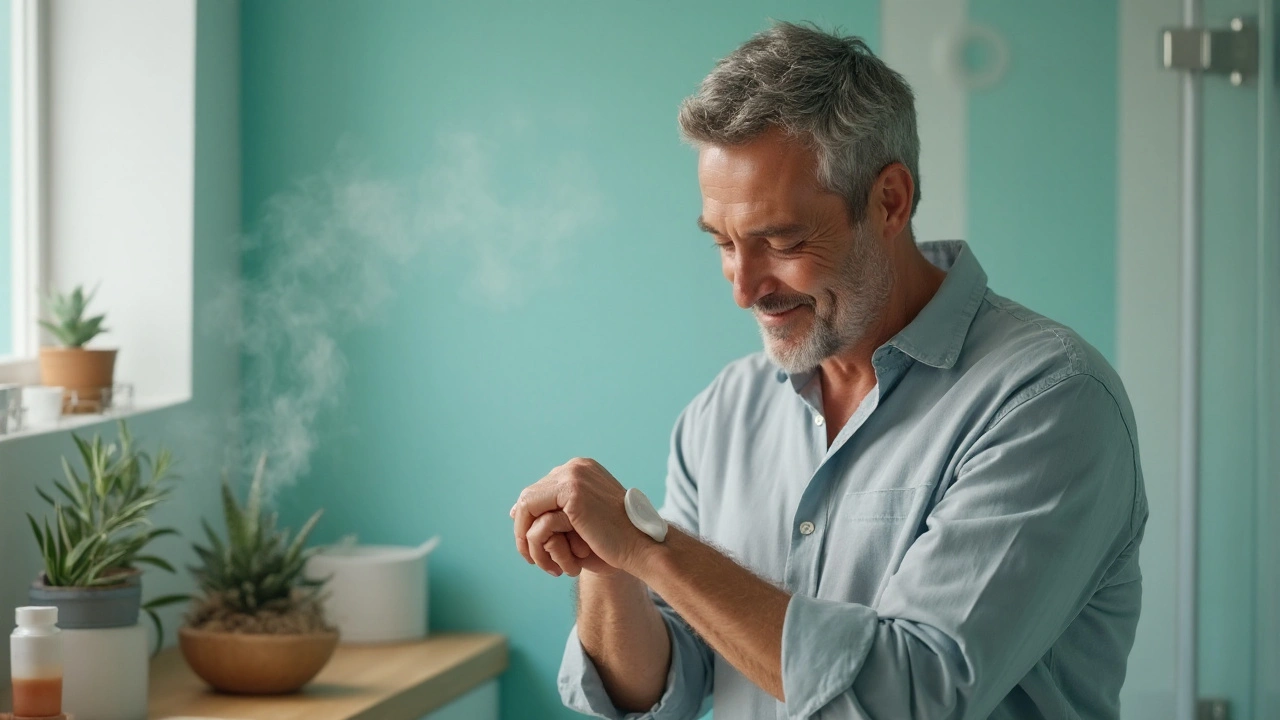Mottled Skin Discoloration Self‑Assessment Quiz
1. How often do you apply broad‑spectrum sunscreen (SPF 30+)?
2. Which of these active ingredients do you currently use?
3. How would you describe your daily sun exposure?
4. Do you consume antioxidant‑rich foods (berries, leafy greens, fish) regularly?
5. Have you had a professional skin assessment in the past year?
Mottled skin discoloration is a pattern of uneven pigmentation that appears as blotchy brown‑to‑red patches, often intensifying with age. It reflects a mix of melanin excess, vascular changes, and loss of collagen.
Quick Take
- Sun protection is the single most effective preventive measure.
- Retinol, vitamin C, and niacinamide are the top over‑the‑counter actives.
- Professional laser or intense pulsed light (IPL) works fastest for stubborn spots.
- Consistent routine-morning sunscreen + nightly antioxidant-delays new discoloration.
- Regular skin assessments with a dermatologist catch early changes.
What Exactly Is Mottled Skin Discoloration?
Unlike isolated age spots, mottling shows a mosaic of darker and lighter zones across the face, arms, or décolletage. The condition blends two main processes: hyperpigmentation - excess melanin production, and vascular hyperplasia - a rise in tiny blood vessels that add reddish tones. Both are natural responses to cumulative UV exposure, hormonal shifts, and the gradual decline of skin’s repair mechanisms.
Key Drivers Behind the Mottling
- UV radiation is the chief catalyst, stimulating melanocytes to dump more melanin and damaging collagen fibers. This creates a feedback loop where uneven texture traps more light, deepening the patches.
- Melanin is the pigment that gives skin its colour. Over‑production or uneven distribution is what we see as dark spots.
- Age‑related decline in collagen reduces the skin’s structural integrity, making pigment appear more pronounced.
- Hormonal fluctuations - especially increased estrogen or progesterone - can trigger melasma‑type mottling.
- Inflammatory acne or eczema scars leave post‑inflammatory hyperpigmentation that adds to the mosaic.
How to Evaluate Your Own Skin
Start with a “mirror test”: in natural daylight, note any patches that differ by more than two shades from your baseline. Use the Fitzpatrick skin type chart to gauge UV sensitivity. Scores 1‑2 (fair) need the most protection; 5‑6 (olive to dark) still benefit from broad‑spectrum sunscreen because UVA penetrates deeper.
If you’re unsure, book a consultation with a dermatologist. They can perform a Wood’s lamp exam to map pigment depth and suggest a tailored regimen.

Daily Habits That Slow Down Mottling
- Sun protection: Apply a minimum SPF 30, broad‑spectrum sunscreen every morning, reapply every two hours outdoors. Look for zinc oxide or titanium dioxide for physical protection, which works regardless of skin tone.
- Wear protective clothing: UPF‑rated shirts, wide‑brim hats, and sunglasses.
- Limit midday sun exposure (10am‑2pm) when UV intensity peaks.
- Consume antioxidants: berries, leafy greens, and omega‑3 fatty acids help neutralize oxidative stress that fuels pigment production.
- Stay hydrated: Adequate water supports the skin barrier, improving the evenness of melanin distribution.
Topical Arsenal: What Works Best?
Four actives dominate the over‑the‑counter market for managing mottled discoloration. They differ by mechanism, concentration, and irritation risk. The table below breaks them down.
| Active Ingredient | Primary Mechanism | Typical Strength | Onset of Visible Results | Irritation Potential |
|---|---|---|---|---|
| Retinol (Vitamin A) | Stimulates collagen synthesis and accelerates cell turnover | 0.25% - 1% | 4‑8 weeks | Medium (dryness, redness) |
| Vitamin C (L‑ascorbic acid) | Antioxidant that inhibits melanin formation (tyrosinase blockade) | 10% - 20% | 2‑4 weeks | Low (stinging if low pH) |
| Niacinamide (Vitamin B3) | Reduces transfer of melanosomes to skin cells, improves barrier | 4% - 10% | 6‑12 weeks | Low |
| Hydroquinone | Directly inhibits tyrosinase, the enzyme that makes melanin | 2% (OTC) - 4% (prescription) | 2‑3 weeks | High (irritation, ochronosis with misuse) |
For most people, starting with a gentle retinol‑Vitamin C combo works well. Use retinol at night, vitamin C in the morning under sunscreen. If you have sensitive skin, swap retinol for niacinamide and add a barrier‑repair cream.
Professional Interventions for Stubborn Patches
When topical agents plateau, clinicians can offer faster, deeper correction.
- Laser therapy - Fractional non‑ablative lasers create micro‑channels that stimulate collagen and break up pigment clusters. Typical sessions: 2‑4 treatments spaced 4‑6 weeks apart. Downtime: 1‑2 days of mild redness.
- Intense Pulsed Light (IPL) - Broad spectrum light targets hemoglobin and melanin, ideal for vascular redness mixed with brown spots.
- Chemical peels - Superficial AHA peels (glycolic, lactic) accelerate turnover, while medium‑depth TCA peels reach deeper pigment.
- Microneedling with radiofrequency - Creates controlled injury that boosts collagen and helps topical actives penetrate better.
Choose a board‑certified dermatologist or a licensed aesthetician experienced in skin‑type specific settings. Over‑aggressive treatment can worsen mottling, especially on darker Fitzpatrick types.
Putting It All Together: A Sample 12‑Week Routine
- Morning: Cleanser → Vitamin C serum (15%) → Moisturizer with niacinamide (5%) → Broad‑spectrum SPF 50+.
- Evening: Cleanser → retinol (0.5%) on alternate nights → Hydrating cream (ceramides, hyaluronic acid).
- Weekly: Exfoliate with a 10% glycolic acid pad (once) to keep cells turning over.
- Month4: Schedule a laser or IPL session if mottling persists despite consistency.
- Quarterly: Visit your dermatologist for a skin check‑up and possible prescription‑strength hydroquinone if needed.
Remember, consistency beats intensity. Skipping sunscreen or over‑exfoliating will undo months of progress.
Related Topics You Might Explore Next
Understanding oxidative stress and its link to premature aging can deepen your skincare strategy. Other useful reads include “How to Choose the Right Sunscreen for Your Fitzpatrick Type” and “Benefits of Peptides in Anti‑Aging Regimens”.

Frequently Asked Questions
Can mottled skin discoloration be prevented entirely?
You can’t stop it forever, but diligent sun protection, antioxidant‑rich diet, and a steady routine of retinol or vitamin C can delay its onset by years. Early prevention is far more effective than trying to reverse deep‑set spots later.
Is hydroquinone safe for long‑term use?
Over‑the‑counter 2% hydroquinone is considered safe for up to 4‑6 months under dermatologist supervision. Prolonged high‑dose use can lead to ochronosis (a permanent darkening). Rotate with other actives and give skin breaks.
How often should I get laser treatments?
Most clinicians recommend 2‑4 sessions spaced 4‑6 weeks apart, then a maintenance session annually. Your skin type and the laser’s intensity will dictate exact scheduling.
Does diet affect skin mottling?
Yes. Foods high in vitamin C, E, and polyphenols reduce oxidative damage that fuels melanin spikes. Conversely, excessive sugar and processed foods can trigger inflammation, worsening pigment irregularities.
Can I use retinol and vitamin C together?
Absolutely, but keep them in separate routines: vitamin C in the morning (helps protect against UV) and retinol at night (boosts turnover). This avoids potential pH conflicts and maximizes each ingredient’s efficacy.
Is IPL safe for darker skin tones?
Modern IPL devices have adjustable filters that reduce risk of hyperpigmentation on Fitzpatrick 5‑6. Still, a test spot and a qualified practitioner are essential before full‑face treatment.



Kyle Garrity
23 September / 2025I totally get how frustrating mottled skin can feel especially when you notice new patches popping up after a sunny weekend. The best first step is to lock in a solid sunscreen habit every single morning no matter the season. Even a broad‑spectrum SPF 30 will block most UVB and a good chunk of UVA that drives melanin spikes. Pair that with a diet rich in berries and leafy greens and you give your skin antioxidants to fight free radicals that worsen discoloration. Consistency is key so set a reminder on your phone to reapply sunscreen every two hours if you’re outdoors. Over time you’ll see the blotchy areas fade and the overall tone even out.